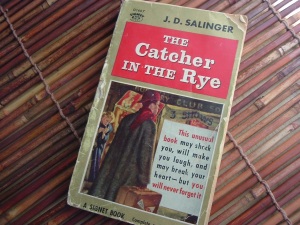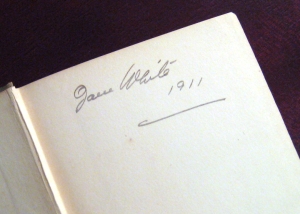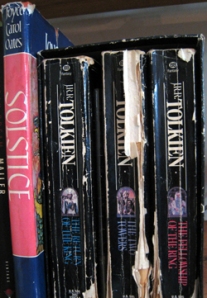I understand the appeal of e-readers.
Seriously.
 However, I have read only one full book using a Kindle (or Kindle app). That was because I wanted to read it NOW.
However, I have read only one full book using a Kindle (or Kindle app). That was because I wanted to read it NOW.
When it comes to e-readers, I like the idea of the immediacy. And I can appreciate the volume of books they hold, the ease of moving them around.
And I guess it’s nice that the font size can be made larger. But…eh. Still, I don’t know.
When I was a teenager, we were buying tapes, and records, and then CDs. I may only have had five records, but I still had them (Depeche Mode’s “Some Great Reward” and INXS’s “Kick” among them). My dad had records, too, lined up side-by-side on the shelf under his turntable, the band and singer-songwriter names in small font on the edges (I remember Chicago, Steely Dan, Billy Joel, and The BeeGees). When I wanted to listen to something, I would sit on the floor and flip through the covers until I found something I liked. When, in my mid-twenties, CDs were mainstream but records hadn’t yet been completely phased out, I flipped through the corner-worn record jackets stuffed tight in the wall-cubby of my new boyfriend’s apartment. What did he like? Who did he listen to? Who was he?
 We do the same with books. We walk into the home of a new friend, a new lover, and one of the first things we scan is the bookshelf. What are you reading? Who do you like? Who are you?
We do the same with books. We walk into the home of a new friend, a new lover, and one of the first things we scan is the bookshelf. What are you reading? Who do you like? Who are you?
The only thing we might notice before that is the art on the walls, but wall-art is intentional. It’s selected carefully, matched to our walls or rugs or living room furniture or personality – because it will be there, hanging at eye-level and on immediate display, for years.
We don’t put the same kind of thought into bringing home books. We walk into a bookstore, pick up a pretty cover, read the back, and buy it. When we’re finished with it, we slide it onto the shelf between a book on houseplants and a collection of short stories we picked up at another store some years ago.
 And we take for granted – more often than not – the utter richness of the experience of reading a book. The simplest of activities, yes, but one that appeals to every one of our senses, even if only subtly, peripherally. The art of the cover draws us first, and its connection to the time of its publication is as telling as the subject matter, the details, of the words inside. Living history, it changes with each new printing and offers us, when we’re lucky enough to find a decades-old copy in a used book store, a tangible bit of the past we can take home with us. We open the cover and are intrigued by who may have owned it before and run a finger over the name written in cursive on the inside cover, then wonder what might have happened to her. Who she was, this woman who for some reason included the year beside her name, and where she lived, how her book found its way to the store.
And we take for granted – more often than not – the utter richness of the experience of reading a book. The simplest of activities, yes, but one that appeals to every one of our senses, even if only subtly, peripherally. The art of the cover draws us first, and its connection to the time of its publication is as telling as the subject matter, the details, of the words inside. Living history, it changes with each new printing and offers us, when we’re lucky enough to find a decades-old copy in a used book store, a tangible bit of the past we can take home with us. We open the cover and are intrigued by who may have owned it before and run a finger over the name written in cursive on the inside cover, then wonder what might have happened to her. Who she was, this woman who for some reason included the year beside her name, and where she lived, how her book found its way to the store.
When we fold back the paperback cover, it is slick and stiff with newness or soft and worn like old, time-rubbed money. The pages are white or they’re tanned by dust and years, flat and thin or grainy, bumpy, and thick – almost cringe-inducing, as when tracing a finger along an oxidized car hood – and the pages’ edges are the color of dandelion smear.
 We bookmark our places with old business cards, Christmas ribbons, envelopes, or shopping receipts, and years after reading, we may find a memory tucked between pages 7 and 8. We curl down corners marking sex-hot scenes and glide ballpoint lines under passages we want to recall. We slide our fingers over the words we love, tear out the pages that piss us off, and hurl incomprehensible narrative across the room. Books are our face-umbrellas in bright sunlight, fans in the heat, levelers of uneven tables, and warm decoration in an otherwise nondescript room. They are our age, they are our parents’ age, they are our grandparents’ age. When we turn the pages, we’re touching time.
We bookmark our places with old business cards, Christmas ribbons, envelopes, or shopping receipts, and years after reading, we may find a memory tucked between pages 7 and 8. We curl down corners marking sex-hot scenes and glide ballpoint lines under passages we want to recall. We slide our fingers over the words we love, tear out the pages that piss us off, and hurl incomprehensible narrative across the room. Books are our face-umbrellas in bright sunlight, fans in the heat, levelers of uneven tables, and warm decoration in an otherwise nondescript room. They are our age, they are our parents’ age, they are our grandparents’ age. When we turn the pages, we’re touching time.
And if we want the font size enlarged, we can put on $5 reading glasses.

Kristen Tsetsi is the author of the post-Roe v. Wade novel The Age of the Child, called “scathing social commentary” and “a novel for right now.” She is also the author of the novels The Year of Dan Palace and Pretty Much True (studied in Dr. Owen W. Gilman, Jr.’s The Hell of War Comes Home: Imaginative Texts from the Conflicts in Afghanistan and Iraq). Kristen’s interview series at JaneFriedman.com offers behind-the-scenes insights into all things writing and publishing.



